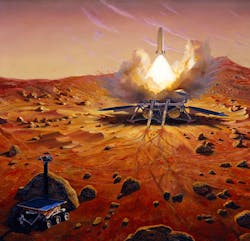The Ultimate STEM Starter: A Manned Space Program
This file type includes high-resolution graphics and schematics when applicable.
It’s hard to believe that youngsters in the United States are not interested in STEM careers and, for the most part, aren’t boning up on the skills and knowledge it takes to get one. After all, their generation has been overwhelmingly immersed in high-tech games and entertainment, high-powered PCs, ever-shrinking cell phones, and a cornucopia of apps. Meanwhile, fascinating breakthroughs in aerospace, bioengineering, transportation, and consumer appliances have been made practically every day.
Don’t they want to be players in that world? Don’t they want to explore new technologies while enjoying high-paying dynamic careers and making the world a better place to live?
The U.S. government seems to think that all the kids need to start them on the road to engineering and technology careers are a few science fairs, some Lego/robotics contests, and “a cohesive national strategy with new and repurposed funds.” So far, such measures haven’t seemed to work. Maybe we should go back to what worked in the 1960-70s: A new space race.
In short, the U.S. should commit to a well-thought-out 20- to 30-year program that puts an occupied base on the moon, a construction-centric space station working in orbit, and humans on Mars, or something equally grand and inspirational. Needless to say, the commitment must include funding, but the effort should be administered more like Kelly Johnson’s Skunkworks than a government agency. And to get the most bang for the taxpayer buck, limit all contracts and suppliers to U.S. companies with no H-1B workers.
It would help if the media accurately covered the effort to explore and exploit space, and provided background information without overhyping it. Some intelligent newscaster, for example, could host a daily show that updates the nation on the efforts and provides scientific/engineering context. Meanwhile, teachers could coordinate class lessons with the space program, tying lessons in math and science to the engineering and accomplishments of the space program.
Sending men and women into space to carry out construction and missions never done before should get kids and adults excited and interested in STEM course and careers. The program would also spur development in a host of technologies and spin-off products.
I’m just as dubious of the worth of putting humans on Mars as the next person. I cannot give a humanitarian reason why going to Mars is better than feeding and housing those in need. But like in the 1950 movie Destination Moon, when the engineering industrialist is asked what the payoff will be for a trip to the moon in terms of dollars and cents, the answer is: “I don’t know. I want to do it because it’s never been done. It’s research, it’s pioneering.” And if that doesn’t give kids a kick in the STEM direction, nothing will.



